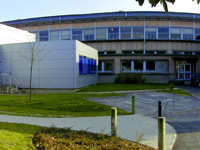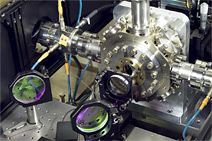 |
|
|
 |
Electron Accelerator R&D for the Energy Frontier

Three European-funded projects, CARE/ELAN, EUROTeV and Euroleap, will meet at LAL, Orsay to review present activities and discuss future plans. |
In the context of actively preparing for future electron accelerators and colliders, there will be a two and a half day meeting at LAL, Orsay starting on 15 May. Three European-funded projects (CARE/ELAN, EUROTeV and Euroleap) will meet to review their present activities and to discuss the future.
The first day covers networking activities of CARE/ELAN, with emphasis on the prospects of new infrastructures within FP7, the next European programme to be launched in October 2006. On the second day, EUROTeV will review its achievements and verify the next steps in the scientific programme. In parallel the newly approved European project on future techniques of acceleration, called Euroleap, will have its kick-off meeting. The last morning is reserved to draw conclusions and to review outreach activities. Please refer to the website http://events.lal.in2p3.fr/ conferences/eaef/ for more detailed information and registration. Registration is now open and free.
This meeting occurs in an important period for the future of the field in Europe: In early May there is a closed session of the CERN Council Strategy Group in Zeuthen, Germany to decide on the future of particle physics in Europe, with strong implications for FP7. One week later a European-GDE meeting will take place in DESY to discuss the prospects for ILC in FP7. Look for reports on these meetings in ILC NewsLine.
-- Barbara Warmbein |
 |
|
|
 |
|
 |
 |
|
|
 |
MAC - Thinking Different

Ferdinand Willeke |
"We will all give our very best to support the ILC design effort in achieving a design that both works and doesn't waste resources," says Ferdinand Willeke, freshly-appointed chairman of the brand-new machine advisory committee - MAC. The committee is a group of 17 'wise old men' who all have a lot of experience and expertise in designing, building and running different accelerators. They come from all types of machines - LEP, the Tevatron, the LHC, HERA, SLC, PEPII, B-factories - and from all over the world. Their mandate is to review GDE accelerator activities and to assist and report to the ILC Steering Committee. They support and advise the GDE in their decision on which technologies and solutions to choose for the ILC, review their cost estimates and milestones and check whether the whole system works.
Willeke calls the work his committee does "the most economic way to avoid mistakes". The ILC is a special case because it combines so many smaller communities and beliefs into one. It is also exciting from a physics point of view because it has to deliver both quality - precision beams, high energy - and quantity - a high luminosity rate. "Sometimes a committee raises new questions," says Willeke, who has been responsible for DESY's HERA for more than 12 years. “It helps the management rethink and distance themselves from the project to look at it from a different angle."
The ILC MAC hopes to do just that. It was called into being by the ILC Steering Committee and met for the first time at Fermilab in early April. There will be three more meetings. At the moment things are looking good: the MAC is impressed with both the progress made and the enthusiasm in the GDE. The members of the MAC will write a report on their findings that will be presented to the International Linear Collider Steering Committee on 8 May in Zeuthen, Germany. The results will be summarised in Newsline.
-- Barbara Warmbein
|
 |
|
|
 |
From The New York Times
18 April 2006
A Real Flip-Flopper, at 3 Trillion Times a Second
Physicists at the Fermi National Accelerator Laboratory reported what would seem to set a new standard for vacillation last week: a subatomic particle that reverses identity three trillion times a second, switching into its upside-down mirror-image evil-twin antimatter opposite and then back again.
The measurement of this yin-yang dance was a triumph for Fermilab's Tevatron, which smashes together trillion-volt protons and antiprotons to create fireballs of primordial energy, and for the so-called Standard Model, a suite of theories that explains all that is known to date about elementary particles and their interactions.
Read more...
From SLAC Today
13 April 2006
ILC Milestone
The International Linear Collider (ILC) group at SLAC recently achieved a milestone with the first generation of 1.3 GHz rf power at End Station B.
This comes a year and half after the decision that the ILC would use 1.3 GHz superconducting cavities for the main linacs. The then NLC—now renamed ILC—group switched from developing high frequency, short pulse rf technology for a SLAC-like linear accelerator (11.4 GHz, 1.5 microsecond), to the low frequency, long pulse rf technology chosen for the ILC (1.3 GHz, 1.5 millisecond).
Read more... |
|
 |
 |
|
|
 |
A BIG MAC Report
Peer review has become a cornerstone of modern science assessments, scientific journal publishing, funding decisons and academic promotions. We actually instituted peer review early in the Global Design Effort when I asked three prominent accelerator physicists from outside our organization to review the baseline configuration before we approved it at Frascati last fall. That committee consisted of Burt Richter (SLAC, Stanford), Lenny Rivkin (PSI, Switzerland) and Katsunobu Oide (KEK, Japan). They each sent us their assessments in individual letter form, and we posted those letters and our responses on the BCD Web pages. We affectionately dubbed that group our “mini-MAC” for Mini Machine Advisory Committee.
Although peer review, in some sense, goes back centuries, it only became an established cornerstone of our academic system during the 20 th century. In fact, many famous papers, such as Einstein’s “Annus Mirabilis,” were not peer reviewed. It is now deeply built into our ability to insure quality standards, to make scientific or funding choices and to provide critiques. Traditionally, it has been done by individual anonymous peer reviewers. While for large complex projects, such as the International Linear Colider, it will be done by an open committee of peers, who will make a joint assessment and report. Sometimes it is amazing that this system works so well. Having been on a number of peer review panels myself, I know that no one gets any smarter by becoming a peer reviewer. The reviewer is typically no smarter and possibly less knowledgeable about the particular subject than the scientists being reviewed. Yet, peer review works because fresh objective eyes are often very useful, and we accept peer review for what it is -- a system that can be very useful but has flaws. We might want to challenge some conclusions, but overall it is a very effective way to obtain objective judgments and advice.
Read more...
MAC Report (pdf)
--Barry Barish
Director's Corner Archive
|
 |
|
|
 |
ILC Related Preprints
hep-ph/0604115
revised 18 Apr 2006
Probe noncommutative space-time scale using gamma gamma -> Z at ILC
hep-ph/0604127
14 Apr 2006
Electroweak radiative corrections to the Higgs-boson
production in association with Z0-boson pair at e+ e- colliders
physics/0604108
13 Apr 2006
The Photon collider at ILC: status, parameters and technical problems
hep-ph/0604107
12 Apr 2006
Dark Matter and the ILC
|

Laser-wire beam profile monitor in the ATF extraction line at KEK. (Photo N. Toge)
|
|

